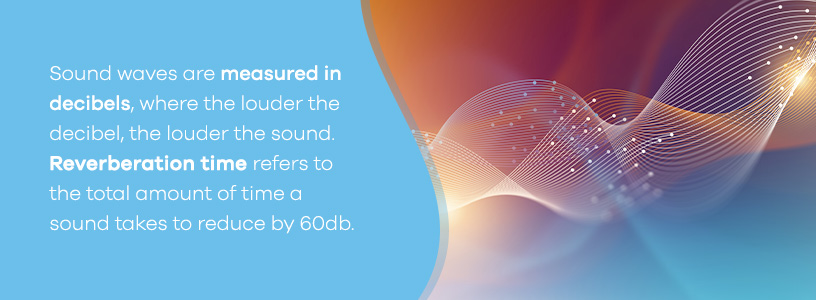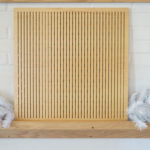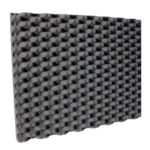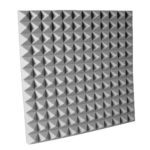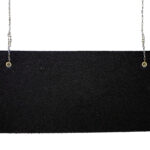
Reverberation plays a key role in any commercial and residential space. Many people blur the defining lines between echoes and reverberations, but they’re slightly different. Reverberations in sound occur when multiple sound waves from a single source bounce off smooth surfaces and come back to your ear in a muddled sound.
This reflection of sound isn’t always a bad thing. If you’re a musician, learning how to manipulate reverb can enhance your melodies. But, if you’re a college professor, you likely want a shorter reverberation time so students can better follow along with your lesson.
Learn more about these key points and how to define reverberation in acoustics below and gain an understanding of the tools you can use to control reverberations.
What is Reverberation?
When you make a sound, sound waves expel from the sources in ripples. The sound waves, full of energy, travel and bounce off surfaces like floors, walls and ceilings until they run out of energy.
Sound reverberation occurs when sound waves bounce off of surfaces and back to your ears, causing a muddied repetition of the original sound.
How Is Reverberation Different From an Echo?
Have you ever yelled into an open room and heard your voice travel back to you from multiple directions? People commonly describe this phenomenon as an echo, but echoes are slightly different than reverberations. Both terms describe a sound that persists after the source stops. But an echo is the distinct reflection of the exact noise, while reverb occurs when sound waves bounce off multiple surfaces and reflect the same noise multiple times.
Why Is Reverberation Important and How Is It Used?
Reverberation isn’t inherently bad. In fact, some sound technicians purposely try to create reverberation. Reverb is key in music-oriented spaces, like music rehearsal rooms, orchestras or performance halls. Music-oriented spaces strive for a longer reverberation time because the reflected sound waves blend the notes more seamlessly, reaching listeners’ ears in a pleasing way.
In most cases, however, you want to strive for a shorter reverberation time. This need is especially true in speech-oriented rooms, such as classrooms. That way, there are less reflected sound waves to audibly dilute the speaker’s message.
What Is Reverberation Time and How Do You Calculate It?
Sound waves are measured in decibels, where the louder the decibel, the louder the sound. Reverberation time refers to the total amount of time a sound takes to reduce by 60db.
You can calculate reverberation time by counting the number of seconds it takes to reduce. For example, if a sound started at 100db and reduced to 40db in two seconds, the calculated reverberation time is two seconds. Measure a sound’s noise level in decibels by using a sound level meter.
How to Control Sound Reverberation
Some ways you can control sound reverberation in residential and commercial spaces are:
1. Acoustic Panels
Acoustic panels are wall-hung soundproofing tools made of compressed mineral wool or foam. They have tiny pores that deaden and dampen sound. When sound waves reach the acoustic panels’ pores, the pores vibrate and transforms the sound energy into kinetic energy, dissipating the sound.
Soundproof Cow offers three types of acoustic panels:
- Art acoustic panels: If you’re looking for functional decorative pieces that don’t look like soundproofing, consider using art acoustic panels. Art acoustic panels are wrapped in fabric with a printed image, like a decorative pattern or a family photo.
- Fabric-wrapped acoustic panels: Similar to art acoustic panels, fabric-wrapped acoustic panels are absorption material wrapped in an acoustic fabric. Customize your fabric-wrapped acoustic panels by choosing a finish and configuration that works with your space.
- Perforated acoustic panels: While art and fabric-wrapped acoustic panels use soundproofing fabric, perforated acoustic panels are strategically carved wood panels that trap sound in their pores.
Customize acoustic panels to your residential or commercial space. Acoustic panels are unique to the room or area you’re soundproofing, so it’s important they’re customizable to complement your room’s size and shape. Choose a color, image or carving style that blends with your room’s or business’s aesthetic.
2. Soundproofing Foam
When you’re thinking about soundproofing equipment, you probably picture soundproofing foam. This product reduces reverberation by catching and absorbing sound waves that dance around the room. Soundproof Cow offers many types of soundproof foam products, such as:
- Pyramid acoustic foam: As its name suggests, pyramid acoustic foam is a polyurethane material with a pyramid-ridged surface. The layered result provides more surface area to absorb sound waves, adding to its soundproofing power.
- Udderly Quiet® Anechoic Acoustic Foam: The Udderly Quiet® anechoic acoustic foam is comparable to the pyramid acoustic foam, except it holds ridges rather than pyramids. These qualities allow this acoustic foam to absorb high, midrange and low-frequency sounds.
- Bass wedge acoustic foam: The bass wedge acoustic foam looks like elongated, steep pyramids that create wedges. These acoustic foam products are a good option if you’re on a budget, as they’re effective and more budget-friendly alternatives to the other foam options.
3. Hanging Baffles
Sound waves travel everywhere around a room, including upwards. Hanging baffles have a fiberglass, foam or cotton core with sound-absorbing properties that prevent acoustic reverberation.
Hanging baffles are common in large, open rooms with tall ceilings. They work similarly to acoustic panels and soundproofing foam, but they’re generally much larger. Hanging baffles have an aluminum frame for support and are typically hung on ceilings or tall walls via chain.
Soundproof Cow offers many types of hanging baffles, including Udderly Quiet® Acoustic Baffle, Udderly Quiet® Anechoic Hanging Baffle, Udderly Quiet® Class A™ Anechoic Hanging Baffle and Echo Absorber™ Hanging Baffle. Some options have a fabric-wrapped finish, resemble soundproof foam or are an exposed natural blend foam. Find one that works well for you, your room and your budget.
Browse Reverberation Soundproofing Products at Soundproof Cow
Whether you’re trying to create a longer reverberation time for your music hall or reduce reverb in your classroom, talk to Soundproof Cow about your goals. Soundproof Cow is a key player in the soundproofing industry. We provide our clients with easy solutions to their soundproofing problems at a competitive price.
Visit us online and browse our reverberation-controlling products. Reach out to us on our online contact form or give us a call at 1-866-949-9269, and we can help you find the best soundproofing solution for your goals.
Learn More About Understanding Sound
Impact Noise vs Airborne Noise
How to Determine the STC Rating of a Wall


